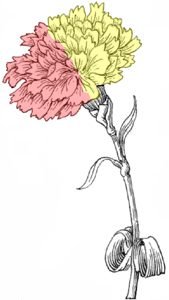ScienceSource Supplemental Lab Activity | Unit A - Chapter 1 |
Investigating Science 10 | Inquiry Activity |
Colourful Carnations and Celery
Skills Reference 2, 10
Skills you Will Use
- Gathering, organizing, and recording relevant data from inquiries
- Drawing conclusions
Safety
The structure and function of plant tissues are related.
Question
How can the rate and movement of water in the xylem tissue be observed in plant stems?
Materials and Equipment
- 3 beakers or glasses
- water
- 3 colours of food colouring
- razor blade
- white carnation (stem, leaves, and flower)
- fresh, crisp celery stalk
- glass slide and cover slip
- dropper
- compound light microscope

Procedure
- Predict what you think the effect will be of placing the stem of a white carnation and a stalk of celery in dyed water for a 24-h period. Record your predictions in your notebook.
- Fill one beaker half-full with water. Add several drops of food colouring to the water until a deep colour is achieved.
- Repeat step 2, adding a different colour to each of the other two beakers of water.
- Using the razor blade, very carefully make a fresh cross-sectional cut of the celery stalk, keeping the stalk under water while cutting. Quickly transfer the stalk, cut side down, to one of the beakers. Make sure the stalk is in the dye and is secure, and then set aside.
- Use the razor blade to make a fresh cut of the stem of the carnation. Again, do this carefully and under water. Also cut the stem lengthwise (longitudinally) approximately halfway up. Place one part of the stem in one beaker and the other part of the stem in another beaker so that the two parts are immersed in two different colours. Set aside.
- Wait for at least 24 hours before observing. Record your observations of the celery stalk and carnation.
- Cut off the bottom of the celery stalk. What do you notice?
- Using the razor blade, very carefully make a thin, transparent, horizontal (cross-sectional) slice of the celery stalk.
- Make a wet mount slide (see Skills Reference 10) by placing the thin slice of celery stalk onto a glass slide and ensuring that it does not fold over. Add a drop of water to the slice and lower a cover slip on top. Observe the slide under low- and medium-power objectives. Draw what you see. Include the magnification on your drawing.
Analyzing and Interpreting
- Why was it important to cut the stalks under water and quickly place them in the beakers?
- What did you notice about the stalks after several hours in the coloured water?
- Describe your observations of the wet mount slide. Which tissue was stained by the food colouring?
- What are you able to infer from the results of this experiment? Explain your inference.
Skill Practice
- Suggest a test or observation that might reveal the other type of vascular tissue found in plants.
Forming Conclusions
- How are the rate and movement of water in a plant stem explained by this experiment?
- Develop a statement to explain how the food colouring moves up the stem of the carnation and the celery stalk.
- Look at the part of the carnation petals that show the dye. How might this observation be related to the water droplets seen on the tips of blades of grass when the soil moisture is high, but the transpiration rate is low? (Hint: The answer is not condensation from the surrounding air.)
